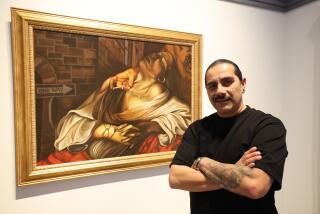Words and Pictures: Viral artist Harmonia Rosales’ first collection of paintings reimagines classic works with black femininity
Harmonia Rosales’ work has gone viral — which is both a good and bad thing.
The Afro Cuban artist’s oil painting “Creation of God” — modeled after Michelangelo’s “The Creation of Adam” with God depicted as a black woman — garnered thousands of likes and comments when it went on Instagram in the spring, attracting big-name fans like Samuel L. Jackson, Willow Smith and Erykah Badu. But it also provoked the ire of trolls.
“It was more shocking not because of the praise but [because of] the negative comments,” the 33-year-old Chicago native said at a VIP opening of her work at a Los Angeles gallery on Saturday. “People said, ‘God should not be a black or Muslim or anything like that,’ and that tells me that what I’m doing is not only what needs to be done, but I need to keep going.”
“This [concept] is not fact. Why have we accepted this image of God being a white male for so long? We should start asking ourselves why.”
This week, Rosales unveils a collection of new paintings in her first gallery exhibit: Black Imaginary to Counter Hegemony at downtown’s Simard Bilodeau Contemporary.
Visitors can see the now-sold “Creation of God” on display along with eight new works through October 15. Here, the artist explains four of her paintings in her own words:
The Creation of God
“I used this particular image [of Michelangelo’s ‘The Creation of Adam’] to deconstruct the old traditional way of thought. Why not take that same image and replace it with the least represented, which is the black woman?”
“The original concept here is Michelangelo created the hidden message of a brain but in replacing God here as a black woman, you see a womb. So it shows strength and empowerment and that we are more valuable than we think.”
Birth of Oshun
“Here is [my take on] the painting ‘The Birth of Venus.’ I wanted to show how we are more similar than we are not. [Greek mythology] is very similar to the religion Santaria. The goddesses and Orishas are very similar. You have Oshun which is Venus. Traditionally, we see Venus as this beautiful woman with flowy hair. My hair never flowed, so I’m wondering why this is supposed to be a painting of the most beautiful woman in the world? So I changed her up and I made her have vitiligo because imperfections are beautiful.
“In Santaria, when you pray to an Orisha, you give them an offering. And her offering happens to be gold so that’s why I made her vitiligo gold.”
“[At right] is Yemaya. She’s the goddess of motherhood, nurturing and love. Oyá [in red] is the goddess that rules over death. Then you have Obatalá who is the equivalent to Jesus, and is a hermaphrodite. Obatalá is the son/daughter of Olodumare, which is God.”
The Virgin
“So this is after, of course, the Virgin Mary. But it has a whole different meaning of being a single mother. I made her young and she’s not as serene because right now she has to grow up. It’s hard work, but it’s all about passing along the knowledge. It’s about raising another queen.”
Lioness
“This was actually the first one I did in the collection. It’s owning your power, your independence, your strength as being a woman. She’s an albino, so she’s still a black woman. This is a hunting picture, so you have a lion being hunted. Men consider themselves lions, when in actuality the lioness is the breadwinner of the family. So it’s about recognizing that and owning that.”
follow me on twitter @sonaiyak
More to Read
Only good movies
Get the Indie Focus newsletter, Mark Olsen's weekly guide to the world of cinema.
You may occasionally receive promotional content from the Los Angeles Times.







